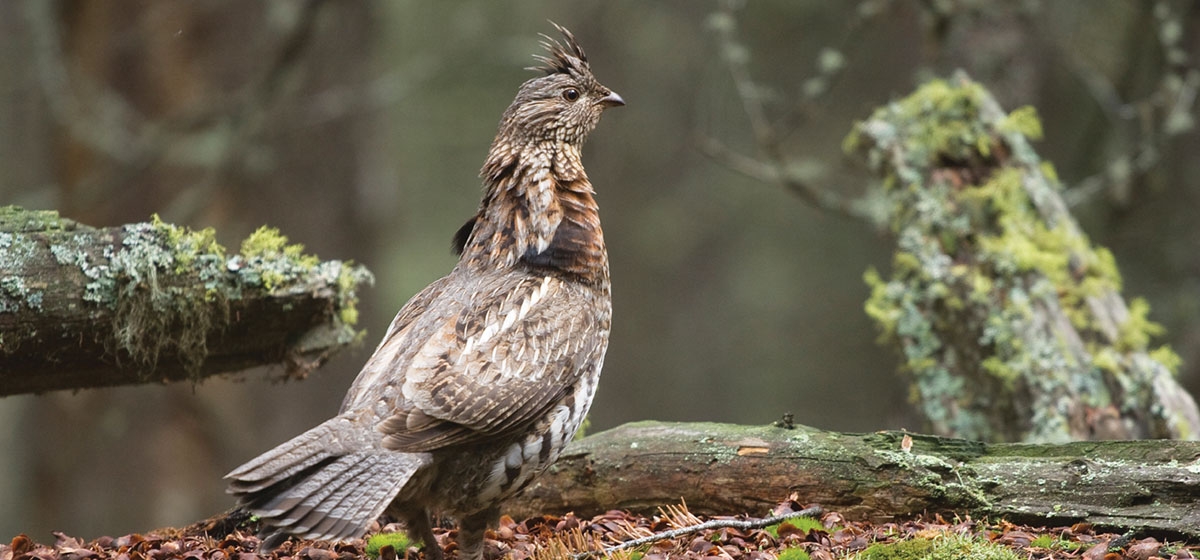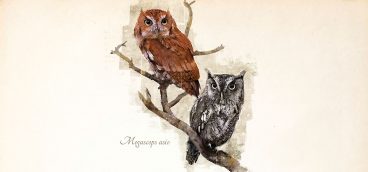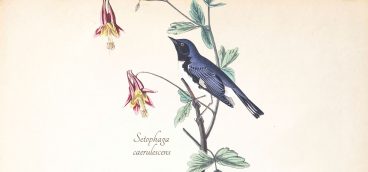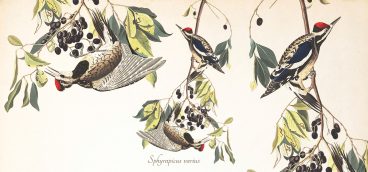
Imagine a bird like a chicken, but a little sleeker, a little more wild. Rufous, gray, with a tail that is barred with black and white stripes at the tips. When the tail pops open in a half circle, it resembles an earth-tone parasol. What’s most visually arresting about the grouse is its collar.
A Ruffed Grouse gets its name from the ruff of feathers around the hind part of its neck and shoulders. It fluffs out like an Elizabethan neck piece, black, feathered and tres chic. Such feathery garb allows the grouse to blend into deciduous forests or mixed hardwood-coniferous stands from Georgia to Alaska, where it happily feeds on a diet of green stuff and wee critters. Ruffed Grouse forage from terra firma to treetop, gleaning as they go. Their varied diets mean that, unlike seasonal songbirds, Ruffed Grouse are with us year-round. That said, I have never seen a Ruffed Grouse. Well, I take that back. There was a stuffed and mounted grouse in my classroom once. It is the state game bird of Pennsylvania, after all, so why not have a specimen on the shelf? Though I’m mildly troubled that since 1931 Pennsylvania has had a state game bird, not simply a state bird, I wonder what teachers could do for environmental awareness if, in addition to the mandated American flag, the state’s bird, tree and flower were pictured on each classroom wall? If this land is your land and my land, as Woody Guthrie said, we’d better make sure our children recognize what’s out there if they’ll have any hope of preserving and protecting it.
I’ve never seen a Ruffed Grouse, but I have often heard them—denizens of the forest understory in hardwood stands surrounded by low, broken brush. They vocalize, but not in typical bird-like fashion. They are percussionists of the air, literally. The male’s “drumming” marks his territory. They drum in any season, but especially in spring, when a male will find a log or other suitable woodland dais, hop up, fix his claws into the bark and expand his ruff to impress prospective mates. With his tail stiffened and body upright and forward, he rapidly fans his wings in a spectacular whirl of feathers that sounds, for lack of a better aural simile, like a lawnmower engine starting up.
Where does the sound come from? John James Audubon thought they beat their sides. Others believed they saw the grouse clap their wings behind their backs. Still others were sure they used logs as drums and wings as drum sticks. But what self-respecting bird would ever use drumsticks of any kind? The fanning is so forceful, rapid and blurred that parsing the motions took 200 years of naturalists’ observations and a movie camera shooting 16 frames a second to get it right. Take advantage of more modern technology and search for “Ruffed Grouse” on YouTube. Far more than a beating in the underbrush, our state fowl is a rhythmic reminder of Pennsylvania’s natural heritage.
A walk in the woods might allow you to hear a drumming grouse, especially next spring. Keep your ears open for a rising rhythm that trails off and later repeats. In some locales, you might draw quite close to a bird that is relatively tame, whereas hunted grouse are quite wary. Legal game for licensed hunters, the bird is celebrated by the Ruffed Grouse Society, a 48-year-old international sportsmen’s group based in Coraopolis that works to “promote conditions suitable for Ruffed Grouse, American woodcock and related wildlife.





